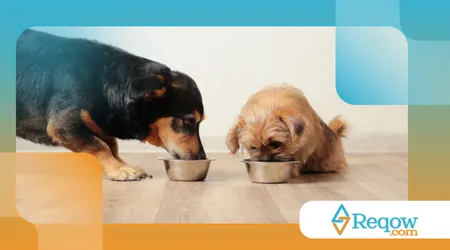How to transition from puppy to adult food

Transitioning from puppy to adult foodYour dog's dietary transition from puppy to adult represents a significant milestone in their life and requires extra attention from their owners.
Advertisements
This process, essential for your pet's health and well-being, must be gradual and well-planned. Abruptly changing your pet's diet can cause serious gastrointestinal upset.
Understanding the right timing and the right approach is crucial. The rapid growth of puppies demands a different energy and nutritional density.
When to Start Changing Your Diet?
The question about the ideal time to start switching food is a common one in veterinary clinics. The exact timing varies mainly depending on the size of your dog's breed.
Small and medium breeds reach nutritional maturity earlier than giant breeds.
Advertisements
Generally, small dogs (up to 10 kg) complete development between 9 and 12 months of age.
Medium-sized ones (11 to 25 kg) tend to make the transition from puppy to adult food around 12 to 15 months.
On the other hand, for large breeds (26 to 44 kg) and giant breeds (over 45 kg), the growth process is slower and can last up to 18 or even 24 months.
Puppy food is rich in calories, protein, and calcium. Too much of these nutrients in an adult can lead to obesity or orthopedic problems.
A veterinarian's assessment is essential to determine the ideal date, taking into account individual factors.
They analyze the animal's weight, body condition, and activity level. Don't anticipate changes on your own; wait for professional advice.
How to Prepare Your Dog for a New Food
Preparing your dog for a new diet involves more than just buying a bag of new food.
In other words, it's a gradual preparation of their digestive system. Your pet's intestines need time to adjust to the new levels of protein, fat, and fiber.
Introducing a new food without due caution can result in vomiting and diarrhea. Many owners, in a rush, try to speed up the process.
However, this rush can compromise the animal's intestinal health. Remember, patience is your greatest ally at this point.
Read more: What to look for when buying a new bed for your dog
The transition should be seen as a marathon, not a sprintThe goal is for the dog to adapt without physical or behavioral stress.
Maintaining a fixed eating routine also contributes to success.
What is the Most Recommended Dietary Transition Protocol?
The most accepted and safest diet transition protocol is a seven- to ten-day period, known as "gradual switching." This method minimizes the risk of digestive imbalances.

Here is the ideal planning:
| Process Day | Puppy Food | Adult Food |
| Days 1 and 2 | 75% | 25% |
| Days 3 and 4 | 50% | 50% |
| Days 5 and 6 | 25% | 75% |
| Day 7 onwards | 0% | 100% |
This schedule allows your dog's body to produce the necessary digestive enzymes. Monitor his stool and behavior daily during this period.
Therefore, if you notice loose stools or diarrhea, slow down the transition process immediately.
Look how interesting: Paw pad care
Return to the previous stage for another day or two. The goal is full adaptation, without adverse reactions.
Why is the Composition of Adult Food So Different from Puppy Food?
The difference in nutritional composition reflects the metabolic needs of each stage of life.
Puppies require energy for accelerated bone and muscle growth. Adults, on the other hand, require nutrients for maintenance and energy.
A study of the Journal of Animal Science 2021 found that the consumption of puppy food by adult dogs can increase the risk of obesity by up to 60% in predisposed breeds.
Growth food is excessively high in calories for an adult dog, whose metabolism is slower.
Adult food generally has a lower fat content and calcium and phosphorus levels that are more appropriate for bone maintenance.
If your dog is a Border Collie, for example, a high-energy working dog, the adult food you choose should be specific.
More information: How to teach your dog to respect other animals on the street
The same applies to a French Bulldog, which is predisposed to weight gain.
Like a locomotive that needs a lot of coal to gain speed, the puppy expends a lot of energy.
When the locomotive reaches cruising speed, the amount of coal required decreases considerably, which illustrates the difference in energy expenditure.
What Mistakes to Avoid When make the transition from puppy to adult food?
The most common mistake is rushing, as already mentioned, changing the diet in just a few days. Another mistake is neglecting the quality of the new food chosen.
Therefore, research renowned brands with a history of nutritional excellence. make the transition from puppy to adult food.
Never mix two brands of adult food unless recommended by your veterinarian. This can unbalance nutrition.
Monitoring your pet's water consumption is also crucial during this transition period. Proper hydration aids digestion and the absorption of new nutrients.

How to Choose the Best Food for Adults?
The best food will be one tailored to your dog's size, age, and activity level. There are foods for active dogs, dogs with a more sedentary lifestyle, large breeds, and small breeds.
To make the transition from puppy to adult food in an informed manner, read the label carefully.
Choose foods with highly digestible proteins, such as meat or chicken, as the first ingredients.
Avoid foods with excessive artificial colors and preservatives. Quality is reflected in health and longevity.
An Essential Step to Longevity and Transitioning from Puppy to Adult Food
The decision to make the transition from puppy to adult food it is an act of responsibility and affection.
Therefore, this dietary change is not just a change in packaging, but a necessary biological adaptation.
By following the gradual transition protocol and veterinary guidelines, you ensure a healthier future.
The correct transition ensures that your pet receives the exact fuel for each stage of life.
Investing time and care now saves you health problems and future expenses. After all, nutrition is the foundation of everything, isn't it?
Frequently Asked Questions
Can I mix puppy and adult food indefinitely?
Not recommended. Mixing should only occur during the transition period (7 to 10 days) to allow the digestive system to adapt.
Mixing for an indefinite period of time can unbalance your dog's adult nutrition, leading to excess calories.
My dog doesn't want to eat adult food; what should I do?
Rejection may occur. Make sure the transition is gradual.
If it persists, consult your veterinarian. He or she may suggest toppings temporary diets or a food with different palatability. Never leave your dog without food for long periods.
Is it normal for a dog to gain weight after moving?
This is not expected if the transition is done correctly and the amount of adult food is adjusted.
If there is weight gain, review the daily portion and exercise level with the help of your veterinarian, as adult dogs have lower caloric needs.
